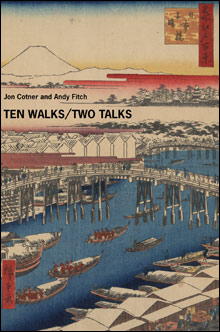
Ten Walks/Two Talks | By Jon Cotner and Andy Fitch | Ugly Duckling PressE | 85 pages | $14 |
It counts as some small death, the blinders-on result of routine, when instead of noticing how the light hits the river or the man in front of the noodle shop crouches as if he'd got no bones, your thoughts pinball from your sandwich to an e-mail you want to write to a ticking of your to-do list. Jon Cotner & Andy Fitch's slim, strange book reminds us that it takes vigilance to see the place in which you live, to pay attention to the world you're moving through.At 85 pages, Ten Walks/Two Talks offers 10 narratives about moving through New York City on foot in early and late spring, each headed by the day of the week that the walk took place. These sections act as collage and kaleidoscope — the combining of disparate observations and the twinkling, morphing picture that results. The sentences detail what's seen on the strolls. Sometimes it's matter-of-fact: "A dwarf carried her mesh Speedo bag off one shoulder (two bananas inside). An elderly pedestrian adjusted a yarmulke." Other times, it's more impressionistic: "Silence and light gathered around tabloid salesmen seated on milk crates at 110th and Lenox." The movement that results from the fluidity and lyricism of the language is slower than cinema; it's not quite like watching images on a screen, but it is like watching. Or, more so, moving.
Cotner and Fitch are our eyes (and noses and ears and feet), but their observations in the walk sections are rarely about them. This is as close as it gets: "Judging from body language boys with facemasks were the coldest," and "I couldn't tell if New York was a sensual city." The streets get filtered through them, sure, but they prove humble guides: "A pony-tailed photographer said Hi from where he lay on slabs, sounded kind and real — made the sixties seem a country people still could visit from." Specific, strange, defamiliarizing. They put to words the thoughts that flash across our brains while we barely notice: "Potted geraniums along the Bowery Bar wall left me worried rowdy people would push them over."
Although the walks take place in New York City, it's not all about New York. The details don't cry out that tired "Only in New York!" refrain. Cotner and Fitch, with their focus and sensitivity and powers of description, could walk around a moldering old mill town, a sleepy suburb, and still find lovely and illuminating scenes and moments. "A girl chipped ice off an SUV. She used something small like a credit card, looked 80% hypnotized." That could happen in Dedham as easily as in Manhattan.
The two dialogues share the meandering atmosphere of the walks. Best to read them less like conversations and more like poems. The talk itself is the thing, the wandering, the flow. And only rarely, and just for a moment, might you think no one actually talks like this, or have thoughts about intellectual stroke-offs ("Aristotle's Nicomachean Ethics addresses this poverty of ethical language"). Like the walks, the exchange ranges from the matter-of-fact ("How about you? What was your dinner?") to the more philosophical ("language-games form the eyeglasses through which we see things").